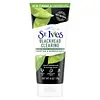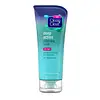What's inside
What's inside
 Key Ingredients
Key Ingredients

 Benefits
Benefits

 Concerns
Concerns

 Ingredients Side-by-side
Ingredients Side-by-side

Salicylic Acid 2%
MaskingWater
Skin ConditioningJuglans Regia Shell Powder
AbrasiveGlycol Stearate Se
EmulsifyingGlycerin
HumectantSodium Lauryl Sulfoacetate
CleansingZea Mays Kernel Meal
AbrasiveCocamidopropyl Betaine
CleansingCetearyl Alcohol
EmollientTriethanolamine
BufferingCetyl Alcohol
EmollientGlyceryl Stearate
EmollientPEG-100 Stearate
Prunus Armeniaca Fruit Extract
Skin ConditioningCetyl Acetate
EmollientCeteareth-20
CleansingCarbomer
Emulsion StabilisingPolysorbate 60
EmulsifyingAcetylated Lanolin Alcohol
EmollientParfum
MaskingPPG-2 Methyl Ether
PerfumingPhenethyl Alcohol
MaskingMethylisothiazolinone
PreservativeCI 77891
Cosmetic ColorantSalicylic Acid 2%, Water, Juglans Regia Shell Powder, Glycol Stearate Se, Glycerin, Sodium Lauryl Sulfoacetate, Zea Mays Kernel Meal, Cocamidopropyl Betaine, Cetearyl Alcohol, Triethanolamine, Cetyl Alcohol, Glyceryl Stearate, PEG-100 Stearate, Prunus Armeniaca Fruit Extract, Cetyl Acetate, Ceteareth-20, Carbomer, Polysorbate 60, Acetylated Lanolin Alcohol, Parfum, PPG-2 Methyl Ether, Phenethyl Alcohol, Methylisothiazolinone, CI 77891
Water
Skin ConditioningGlycerin
HumectantSodium Laureth Sulfate
CleansingMicrocrystalline Cellulose
AbsorbentCellulose
AbsorbentLauryl Glucoside
CleansingAcrylates/C10-30 Alkyl Acrylate Crosspolymer
Emulsion StabilisingPhenoxyethanol
PreservativeParfum
MaskingMethylparaben
PreservativeMicrocrystalline Wax
Emulsion StabilisingSodium Hydroxide
BufferingMenthol
MaskingDisodium EDTA
Sodium Benzotriazolyl Butylphenol Sulfonate
UV AbsorberUltramarines
CI 73360
Cosmetic ColorantTalc
AbrasiveBlue 1 Lake
Cosmetic ColorantCI 19140
Cosmetic ColorantWater, Glycerin, Sodium Laureth Sulfate, Microcrystalline Cellulose, Cellulose, Lauryl Glucoside, Acrylates/C10-30 Alkyl Acrylate Crosspolymer, Phenoxyethanol, Parfum, Methylparaben, Microcrystalline Wax, Sodium Hydroxide, Menthol, Disodium EDTA, Sodium Benzotriazolyl Butylphenol Sulfonate, Ultramarines, CI 73360, Talc, Blue 1 Lake, CI 19140
 Reviews
Reviews

Ingredients Explained
These ingredients are found in both products.
Ingredients higher up in an ingredient list are typically present in a larger amount.
Glycerin is already naturally found in your skin. It helps moisturize and protect your skin.
A study from 2016 found glycerin to be more effective as a humectant than AHAs and hyaluronic acid.
As a humectant, it helps the skin stay hydrated by pulling moisture to your skin. The low molecular weight of glycerin allows it to pull moisture into the deeper layers of your skin.
Hydrated skin improves your skin barrier; Your skin barrier helps protect against irritants and bacteria.
Glycerin has also been found to have antimicrobial and antiviral properties. Due to these properties, glycerin is often used in wound and burn treatments.
In cosmetics, glycerin is usually derived from plants such as soybean or palm. However, it can also be sourced from animals, such as tallow or animal fat.
This ingredient is organic, colorless, odorless, and non-toxic.
Glycerin is the name for this ingredient in American English. British English uses Glycerol/Glycerine.
Learn more about GlycerinParfum is a catch-all term for an ingredient or more that is used to give a scent to products.
Also called "fragrance", this ingredient can be a blend of hundreds of chemicals or plant oils. This means every product with "fragrance" or "parfum" in the ingredients list is a different mixture.
For instance, Habanolide is a proprietary trade name for a specific aroma chemical. When used as a fragrance ingredient in cosmetics, most aroma chemicals fall under the broad labeling category of “FRAGRANCE” or “PARFUM” according to EU and US regulations.
The term 'parfum' or 'fragrance' is not regulated in many countries. In many cases, it is up to the brand to define this term.
For instance, many brands choose to label themselves as "fragrance-free" because they are not using synthetic fragrances. However, their products may still contain ingredients such as essential oils that are considered a fragrance by INCI standards.
One example is Calendula flower extract. Calendula is an essential oil that still imparts a scent or 'fragrance'.
Depending on the blend, the ingredients in the mixture can cause allergies and sensitivities on the skin. Some ingredients that are known EU allergens include linalool and citronellol.
Parfum can also be used to mask or cover an unpleasant scent.
The bottom line is: not all fragrances/parfum/ingredients are created equally. If you are worried about fragrances, we recommend taking a closer look at an ingredient. And of course, we always recommend speaking with a professional.
Learn more about ParfumWater. It's the most common cosmetic ingredient of all. You'll usually see it at the top of ingredient lists, meaning that it makes up the largest part of the product.
So why is it so popular? Water most often acts as a solvent - this means that it helps dissolve other ingredients into the formulation.
You'll also recognize water as that liquid we all need to stay alive. If you see this, drink a glass of water. Stay hydrated!
Learn more about Water